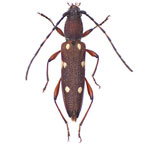Eburophora
White
Cerambycinae
Eburophora White, 1855: 332. Type species: Eburophora octoguttata White, 1855.
Diagnosis
Small brown beetles bearing yellow markings on elytra; antennae in male not reaching beyond apices of elytra. Frontoclypeus transverse. Gland opening at base of mandibles absent. Eyes finely facetted, deeply emarginate. Antennal tubercles broadly separated. Antennal foramen depressed, close to mandibular articulation. Antennal scape distinctly shorter than pronotum; pedicel as long as wide; antennomere 3 longer than scape; antennomeres 3–7 with apical spines. Pronotum transverse or subquadrate, lateral margins spinose medially; pronotal disc nodulose. Prosternal process broad, expanded apically. Procoxal cavities rounded without lateral extensions; open externally. Procoxae weakly projecting below prosternal process. Mesoventrite flat in front of mesocoxae; mesoventral intercoxal process broad, with secondary articulation, notched apically. Mesocoxal cavities closed to mesepimeron; mesotrochantin hidden. Elytra without costae with ivory-coloured spots; punctures clearly visible not in regular rows, apices spinose. Femora weakly expanded medially; tibiae not flattened.
Distribution and Biology
The genus is endemic to south-eastern Australia, known from South Australia, Victoria, New South Wales and the Australian Capital Territory.
Adults have been collected from October to December.
Australian Species
eburata (Pascoe)
Sophron eburatus Pascoe, 1865: 374.
octoguttata White
Eburophora octoguttata White, 1855: 332.
References
Pascoe, F.P. 1865. A second series of descriptions of new Australian longicornia. Journal of Entomology 2(12): 352–374 pl. xvi.
White, A. 1855. Catalogue of Coleopterous Insects in the Collection of the British Museum. Part viii. Longicornia II. London : British Museum iii 175–409 pls v–x.
